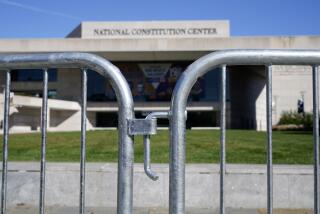U.S. Firms Sold Advanced Technology to Iraq : Trade: The sales reflect past White House willingness to help Baghdad.
WASHINGTON — Last February, a Silicon Valley company sold sophisticated electronic imaging and photographic equipment to Iraq that could be used for aerial reconnaissance and missile targeting, a government official and a former Pentagon official said Monday.
The shipment from International Imaging Systems in Milpitas, Calif., was approved by the Commerce Department, despite years of objections from the Pentagon, which at one time had the equipment seized by the U.S. Customs Service.
“It was a very tough battle, but I thought we had won and this material would not be going to Iraq,” said Stephen Bryen, a former deputy assistant secretary of defense for export policy and opponent of the sale.
The shipment illustrates the willingness of the Reagan and Bush administrations to assist Iraq during and after its eight-year war with Iran. Both administrations opposed efforts in Congress to impose trade sanctions on Iraq, and U.S. trade with Baghdad grew dramatically during the late 1980s.
A study being prepared by the Wisconsin Project on Nuclear Arms Control and data gathered by the Senate Foreign Relations Committee show that at least 10 U.S. companies have provided Iraq with advanced technology that could be used for both commercial and military purposes.
In addition, companies in other Western nations now aligned against Iraq sold billions of dollars’ worth of technology to the country as Saddam Hussein developed his military machine. West Germany leads the list of suppliers, followed by Austria, the United States and Britain.
“To call this policy shortsighted is a gross understatement,” said Gary Milhollin, a University of Wisconsin law professor and director of the Wisconsin project.
Much of the Western technology was used to build and equip a huge missile-development center called Saad 16 in the Iraqi city of Mosul, according to Milhollin’s study. For instance, the study says that $1 million worth of Hewlett-Packard computer equipment was shipped to a West German firm, which then sent the computers on to Saad 16.
Hewlett-Packard, the Palo Alto computer manufacturer, obtained proper U.S. export licenses for the sale.
In the case of the electronic imaging equipment from International Imaging, the contents and specific destination of the February shipment to Iraq are not known. A Commerce Department spokesman said he was prohibited by law from discussing any foreign export.
Executives at International Imaging did not return telephone calls from The Times last week. Tony Musladin, a vice president at the firm, hung up on a Times reporter Monday after saying only: “I do not wish to participate with the Los Angeles Times on anything that the Los Angeles Times might come up with.”
International Imaging was once owned by Albert V. Hakim, the Iranian-born businessman who pleaded guilty last year to a misdemeanor in the Iran-Contra scandal.
In the 1970s, the company had a large contract with the Iranian military to provide equipment used to process images and transmit data from satellites. One of its consultants at the time was Frank E. Terpil, a renegade CIA agent later charged with smuggling arms to Libya in an unrelated episode. A company executive told The Times in 1987 that Terpil was paid $24,000 for arranging a single contract in 1976.
Under new ownership since 1981, the company is a leader in developing computer-enhanced photographic technology with a variety of commercial and military applications. In the military sphere, such equipment can be used in surveillance from airplanes and satellites and in targeting missiles.
For instance, an executive with a similar firm said U.S. cruise missiles are guided by a computer-enhanced system that relays electronic photographs of the terrain over which the missile is passing so that its destination can be adjusted as it flies.
When the equipment was first proposed for export to Iraq in late 1985, International Imaging told the government that it was going to be used for forestry conservation, soil analysis and cartography, according to Bryen. It was to be shipped to Iraq’s space and astronomy research center in Mosul.
Bryen said that the sophistication of the technology and its potential use in missile targeting and reconnaissance raised concerns at the Pentagon. He said alarms also were raised by the research center’s proximity to the missile-development facility, then under construction.
Iraq was not on the list of countries forbidden to receive U.S. technology. The only two grounds for blocking the export were a fear that the material would be sent on to the Soviet Union or evidence that it would not be used for the purpose specified on the export license.
“We were able to show definitive evidence of its military end use,” said Bryen. “On that basis, we were able to get the actual seizure.”
Bryen said Paul Freedenberg, undersecretary of commerce for export administration in the Reagan Administration, agreed to rescind the license and stop the export over objections from the State Department.
Freedenberg said Monday that he could not recall the incident and that he would be prohibited from commenting on it even if he did. He did say, however, that no policy existed against exports to Iraq until the invasion of Kuwait on Aug. 2.
International Imaging continued to seek approval for an export license. A government official, who spoke on condition that his name not be used, said the license was eventually granted and the shipment took place last February.
More to Read
Inside the business of entertainment
The Wide Shot brings you news, analysis and insights on everything from streaming wars to production — and what it all means for the future.
You may occasionally receive promotional content from the Los Angeles Times.










